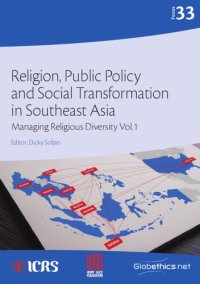
Ebook: Religion, Public Policy and Social Transformation in Southeast Asia: Managing Religious Diversity
Author: Dicky Sofjan (ed.)
- Genre: Religion
- Tags: Public policy religious politics social transformation social change antireligious movements new global order confessional management global politics toward religious confessions
- Series: Managing Religious Diversity No. 33
- Year: 2016
- Publisher: Globethics.net Focus
- City: Geneva
- Edition: 1
- Language: English
- pdf
The study of religion analysed through the lens of public policy.
Southeast Asia is arguably one of the most diverse regions of the world. The subregion’s population of more than 500 million people
maintain a variety of cultures originating from China, the Middle East (Arab, Persian and Turkish), the Indian subcontinent, Java, Melanesia and of late Western European/American influences in which the latter largely came to shores of the region through the vast and expansive project on colonialism. The passing of cultures and the influences of many great civilizations on the region have created a rich tapestry that not only impacts how the people live, think and feel, but also their faith, religion and worldview.
The great diversity of religions in Southeast Asia proves how open Southeast Asia has been throughout past centuries with the spread and development of world religions and their main strands, namely Buddhism (Theravada and Mahayana), Islam (Sunnism and Shiasm) and Christianity (Protestantism and Catholicism). Aside from the prevalence of these so-called “world religions”, Southeast Asia is home to a multitude of ‘local’ or ‘indigenous religions’ and traditional belief systems. Such blending and diversity should surely be celebrated, and considered as a blessing for the region. However, the reality shows that the modern, post-colonial nation-states of Southeast Asia have had to contend with religion in ways that contradict the very fundamental and
universal teaching of religion, which is to promote tolerance, mutual respect, peaceful coexistence and social justice.
Notwithstanding, the phrase “managing religious diversity” begs a rather practical set of questions. How does a state manage religious diversity? How do faith-based communities and religious groups or organizations engage the state? And how do they respond to constant political reconfiguration or state repression? No doubt, in Southeast Asia, these questions are both pertinent and urgent.
This book series deals with religion and its interface with the state and society in Southeast Asia. It examines the multidimensional facets of politics, public policies and social change in relation to contemporary forms of religions, religious communities, thinking, praxis and ethos. All articles in this Book Series were a direct result of a policy-relevant research collaboration conducted by investigators from the participating countries from 2013–2016. The issues under examination in this Series include: state management of diversity, multicultural policies, religious social activism and state-society relations. All of the analyses in this Book Series are fixed within the context of a rapidly changing society in Southeast Asia.
Southeast Asia is arguably one of the most diverse regions of the world. The subregion’s population of more than 500 million people
maintain a variety of cultures originating from China, the Middle East (Arab, Persian and Turkish), the Indian subcontinent, Java, Melanesia and of late Western European/American influences in which the latter largely came to shores of the region through the vast and expansive project on colonialism. The passing of cultures and the influences of many great civilizations on the region have created a rich tapestry that not only impacts how the people live, think and feel, but also their faith, religion and worldview.
The great diversity of religions in Southeast Asia proves how open Southeast Asia has been throughout past centuries with the spread and development of world religions and their main strands, namely Buddhism (Theravada and Mahayana), Islam (Sunnism and Shiasm) and Christianity (Protestantism and Catholicism). Aside from the prevalence of these so-called “world religions”, Southeast Asia is home to a multitude of ‘local’ or ‘indigenous religions’ and traditional belief systems. Such blending and diversity should surely be celebrated, and considered as a blessing for the region. However, the reality shows that the modern, post-colonial nation-states of Southeast Asia have had to contend with religion in ways that contradict the very fundamental and
universal teaching of religion, which is to promote tolerance, mutual respect, peaceful coexistence and social justice.
Notwithstanding, the phrase “managing religious diversity” begs a rather practical set of questions. How does a state manage religious diversity? How do faith-based communities and religious groups or organizations engage the state? And how do they respond to constant political reconfiguration or state repression? No doubt, in Southeast Asia, these questions are both pertinent and urgent.
This book series deals with religion and its interface with the state and society in Southeast Asia. It examines the multidimensional facets of politics, public policies and social change in relation to contemporary forms of religions, religious communities, thinking, praxis and ethos. All articles in this Book Series were a direct result of a policy-relevant research collaboration conducted by investigators from the participating countries from 2013–2016. The issues under examination in this Series include: state management of diversity, multicultural policies, religious social activism and state-society relations. All of the analyses in this Book Series are fixed within the context of a rapidly changing society in Southeast Asia.
Download the book Religion, Public Policy and Social Transformation in Southeast Asia: Managing Religious Diversity for free or read online
Continue reading on any device:

Last viewed books
Related books
{related-news}
Comments (0)